NASCAR's first round of 2014 car tweaks? Well, we all know the problems. What are the answers?
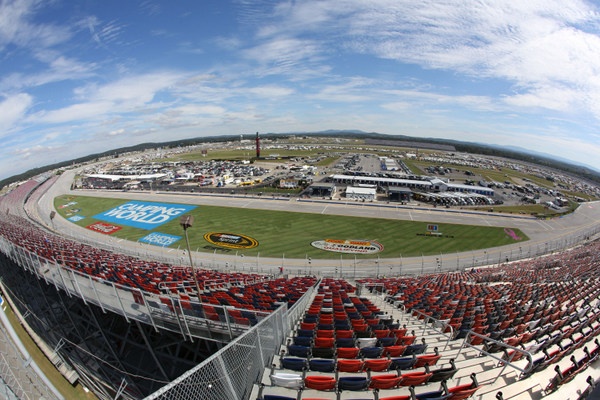
Maybe if drivers didn't just park-and-ride-home after 10 laps or so of practice, there might be more fans in the Talladega stands Friday. How is parking 'giving 100 percent'? (Photo: Getty Images for NASCAR)
By Mike Mulhern
mikemulhern.net
TALLADEGA, Ala.
The 2013 stockers look spiffy and drive cool, yes.
But as far as changing the racing dynamic out on the track, especially the Sprint Cup tour's nine mid-sized 1-1/2-mile tracks, which host so many of the sport's big events, nothing much has really changed since last season, or the year before.
The lead car still has a very sizeable aerodynamic advantage. Rivals still find it hard to pass, except on the two-abreast restarts.
So NASCAR is looking to tweak the cars for next season, hence Monday's six-car test at Charlotte Motor Speedway.
How to make for more passing on the stock car tour's 1-1/2-mile tracks?
How to take away the lead car's aerodynamic edge?
That's NASCAR's goal, and various ideas were tested.
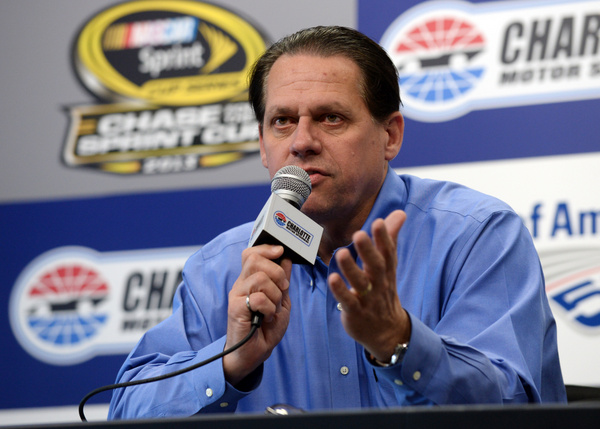
The new boss of the NASCAR rulebook rewrite project: Gene Stefanyshyn. Listening to teams to get ideas (Photo: Getty Images for NASCAR)
Expect bigger rear spoiler blades, a couple of odd 12x8 aero-holes in the rear bumper, maybe some new, higher front 'splitters,' maybe 'wicker strips' across the roof, but no 'tapered spacers' on the engine, according to stock car teams analyzing the test.
NASCAR's Gene Stefanyshyn, the ex-GM guy now in charge of the sport's rulebook, has been going hauler to hauler for one-on-ones with crews asking for suggestions about how to make racing better on the 1-1/2-mile tracks, where 'clean air' has given any race leader a decisive edge over those in his wake.
Using 'tapered spacers' -- think a type of carburetor restrictor plate -- to slow speeds is what NASCAR has used in the Truck and Nationwide series, and NASCAR tested that in a Cup test last December and again at Charlotte Monday. But Cup drivers do not appear enthusiastic about using the speed-slowing device, because it tightens up the pack.
The Monday test drew mixed emotions from teams here. Some appreciated Stefanyshyn's approach and ideas; others scoffed that changes like those tested "would cost each car owner $1 million," according to one crew chief.
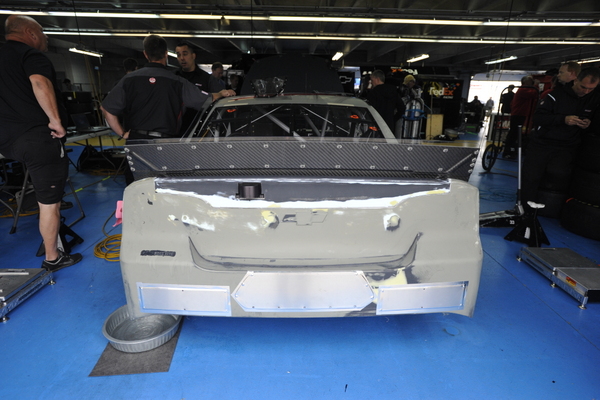
That new rear spoiler is how big? And what's the deal on those two new big, square holes in the rear bumper? (Photo: Getty Images for NASCAR)
The tested front splitters were apparently designed to let more air get under the car; the holes in the rear bumper were designed to let air escape from under the car. The six test drivers -- Jamie McMurray, Brad Keselowski, Trevor Bayne, Denny Hamlin, Brett Moffitt (in Brian Vickers' car), and Jeff Burton -- ran a couple of the 15 to 20-lap sessions like that, but nothing much seemed to be different.
The cars would leave pit road one at a time, and the first car out would straightaway the rest of them, just like has been happening during races at the 1-1/2-miles.
Then NASCAR put the bigger spoiler on the rear. That seemed to close things up, and that first car out wasn't able to break away. In fact there was some side-by-side racing and passes for the lead.
Then NASCAR put the 'spacer sleeves' on the engine, to choke off some air; that slowed the cars some but didn't affect the drivers' racing otherwise.
During the opening test runs, the lead car would be going into turn one as the second place car was crossing the start-finish line. During the final test runs, the lead car at the start-finish line would have the second-place car right behind, and the last place car would be coming off turn four.
The next step is unclear.
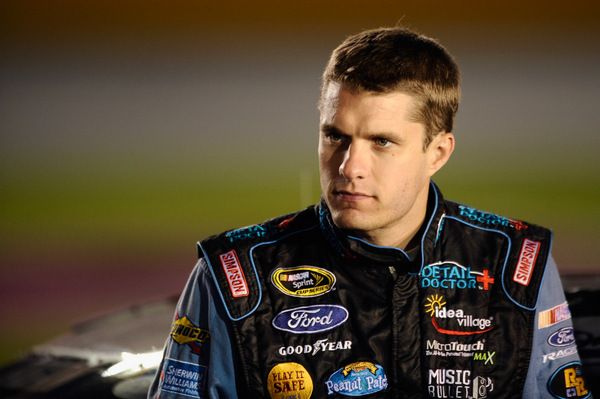
David Ragan: remember his furious finish here at Talladega to win back in the spring? Well, he's got a few ideas on how to tweak these cars for better racing on the 1-1/2-mile tracks.... (Photo: Getty Images for NASCAR)
David Ragan, who won this spring's Talladega 500 in that furious finish, and who has parlayed that into a contract renewal, doesn't expect to be as fortunate this time. Lightning doesn't usually strike twice for such modestly financed teams.
Still Ragan knows he has a better shot at winning here than he did at Charlotte last weekend or at Texas in two weeks.
Because those mid-sized tracks have become high-tech engineering projects for the big-dollar teams.
How much that might figure into NASCAR's plans for 2014 tweaks is not obvious.
"The 1-1/2-mile tracks take a lot of resources to figure out your aero platform, and how you are riding on your bump-stops, and research and design to kind of trick the system," Ragan says. "The set of rules NASCAR has, if you can figure out not necessarily how to beat the rules but how to use them to your advantage, that requires a lot of money, testing, and people. And that is somewhere we fall short at.
"You get to a speedway (like this wide-open track) and Martinsville next week where you go back to the mechanical things that we all grew up racing, and it is a little simpler. Some of our best finishes this year have been at Bristol, Richmond, the speedways and the road courses."
The new 2013s, pitched as all but a cure-all for this sport's lackluster racing the past few years, have however changed up the strategy here, Ragan says:
"What we have learned with the Gen-6 car is that you can't be so conservative throughout the day and just expect an easy move toward the front in the closing laps. You have to make the commitment to get to the front as soon as you can; and you will see some harder racing throughout the day trying to keep that track position.
"You just can't improve your position as quick as you could (here) four or five years ago."
Which Ragan says should keep drivers from playing rope-a-dope by riding around in the back of the pack hoping to avoid the big crash. Denny Hamlin found that out in the spring, where he got lapped early.
"In years past you could ride half-throttle and you wouldn't lose the draft," Ragan says. "Now what we have learned with the Gen 6 car -- and I don't know if it is the aero package or the rule with our (engine) intakes that allow the air to our radiator where we can't run any tape -- but you can't ride. That last car in the pack is very subject to lose the draft. You have seen some very strong cars -- Denny Hamlin -- lose the draft.
"You can't tandem up anymore, because of the water temperature issues you will have.
"You can't make efficient passes very quick."
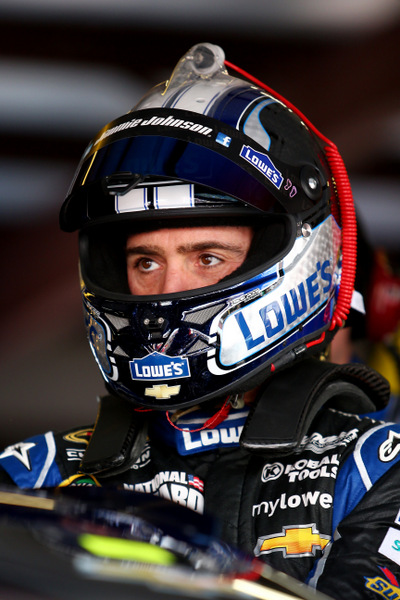
No, it's not George Clooney suited up for Gravity. It's Jimmie Johnson plotting strategy for Sunday's 500, at one of his worst tracks. Looks like it's pretty straightforward: show the fastest car, win the pole Saturday), stay ahead of the Big One Sunday. Johnson had the fastest car in Friday solo runs, at 195.936 mph. Laps in the draft itself of course will be well over 200 mph (Photo: Getty Images for NASCAR)
Ragan also says title contenders like leader Matt Kenseth and Jimmie Johnson "have to be a little more conservative, because they have to get through this week without a 30th place finish, without a DNF.
"The guys not in the Chase can be a little more aggressive behind the wheel, and our crew chiefs can take a few more chances on pit road, maybe stretch fuel mileage, maybe not take tires that last pit stop."
The three men in the middle -- Kevin Harvick, Jeff Gordon and Kyle Busch -- they're the real wild cards here. They've got to make something happen in Round Six of the 10-race chase, and hope Kenseth and Johnson stumble. Time is running out in the playoffs.
But this is plate racing, and NASCAR is focused more at the moment on fixing these cars for better racing on the 1-1/2-miles.
Yes, NASCAR's Stefanyshyn ought to be rethinking a few things about plate racing: like this one-engine/impound rule, that lets drivers run 10 laps of practice and then park for the day, and like the engine-temperature limitations, that have drivers spending more time watching their water gauges than rivals. If NASCAR's new credo is to insist drivers 'give 100 percent,' how is parking your car and heading home after just 10 laps of practice 'giving 100 percent'?
However it's the mid-size tracks that NASCAR really needs to fix. Virtually every race at those tracks the past two years at least, two drivers have typically dominated most of the action, and for long stretches of boring green.
Ragan?
"I don't really know all the questions, much less the answers," Ragan says slowly. "The first thing is you have to know the questions to figure out what to do."
But he goes on to say "I have been a big advocate that racing is better if the cars are easier to drive.
"If the cars are hard to drive, we are on pins and needles and don't take as many chances; we are just trying to race our race and not racing others.
"If you look at some of the tracks where you can move around, the tire combination is right, the cars are handling well and you can move from the top to the bottom, that is when the racing is best.
"In my opinion, I would like to see the cars lose a little horsepower and downforce, slow them down just a hair, and that would make for, in my opinion, a little better racing."
And Ragan quickly trots out the now-tired NASCAR-sanctioned dogma that "the Gen-6 car has been everything and more of what we wanted it to be as an industry."
But.....
"If we could figure out how to tweak the 1-1/2-mile racing so the cars aren't so aero-dependent -- and you can catch a car and pass them, or move around, I think that is the biggest thing.
"And the teams, NASCAR, Goodyear can all get in a little better circle and communicate better so we don't have the issues like at Kansas with the temperatures and tires reacting like they did...
"If we can improve a few small issues like that, it would be very good."
Again, the coda:
"But the product we have is extremely great, and better than we all expected for the first year of the Generation 6 car. It has exceeded all expectations, and has a lot of sped, a lot of track records, a lot of passes and a lot of racing."
A lot of boring racing, as last weekend's 75,000 fans watched at Charlotte.
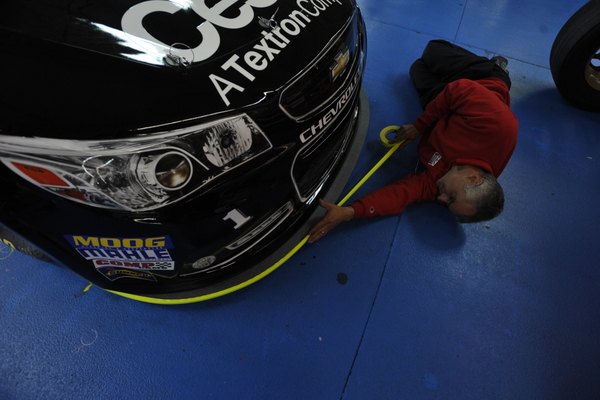
New front spoiler rules coming? (Photo: Getty Images for NASCAR)
© 2010-2011 www.mikemulhern.net All rights reserved.
Web site by www.webdesigncarolinas.com







Passing
There needs to be different setup under the cars. With all cars running the same springs, shocks, rear gear ratio and rear spoiler angle and all have the same top speed to a 100th of a MPH how can there be passing??? Racing is when you see one car pass 2 or 3 cars at one time going into a corner or down the straights. The fast cars can not even pass the back markers unless they let them on the straights because of the same top speeds.
Hot Dog Wrappers
I don't pull for Little E at all, BUT in a perfect world you could say a hot dog wrapper cost him the race. He had to slow down quite a while till he could get behind someone. Why in the world does NASCAR let this have to happen? Why can't they mandate a much much much larger grille opening. Could this do away with the hot dog wrapper overheating AND slow the lead car at the same time??? Million dollar cars killed by hot dog wrappers, sheesh.
coil binding & bump stops
I don't remember the aero push being a problem before they started using bump stops and coil bindings. Has NASCAR considered testing without the bump stops and coil bindings? This would take some of the down force away and slow the cars down somewhat. This would also be more like the cars we drive on the street.... in other words, stock cars.
passing
The air around the greenhouse of the car needs to be dirtied up a little. Take out all the side windows and increase the spoiler height. Close up the front grill allowing only radiator openings and Put the naca ducts directly behind the front wheels on the upper part of the fender to cool brakes on mile and a half tracks on up. (simular to the 77 Pontiac Trans-Am) Get rid of bumpstops, shock packers, gear rules, spring rules. Make the car more reliant on mechanical grip rather than downforce. Make a tire that wears a little more with more grip making gas n go stops gone. If the car has to rely on mechanical grip rather than aero grip there will be all the passing you can handle in a race.
Passing And Where To Find It
I'm puzzled at no mention of whether the roof blade was tested in the Charlotte session, as it was initially reported the roof blade was to be part of the test. Given that the draft has been effective on the intermediates (see noptably the Truck and Busch Series races at Kansas this past season) and the low-banked superovals like Pocono, Michigan, Fontana, and of course back in the day at the old Ontario Motor Speedway, it would stand to reason the roof blade would work today.
The bigger spoiler clearly helped open up passing. The spacer sleeves we've seen work with the Busch Series and the Trucks so I'm pretty confident if NASCAR went that road it wouldn't hurt.
The Talladega end of the issue further points to the rules ineptitude of John Darby and Brian France. The radiator/cooling rules are beyond absurd, and the hatred of the concept of tandem drafting by NASCAR stopped making sense almost right away - as the Busch Series keeps proving, tandem drafting is the strongest power to pass racing has ever seen, and it no longer looks weird (the real reason people hate it) as it keeps evolving back toward pack racing; we saw this in both Daytona Busch races and at Talladega's Busch race in April.
Clem Zahrobsky recommends allowing different setups for teams - I don't necessarily disagree here, but I think the Busch and Truck series have the same setup rules (running the same shocks, springs, etc.) for their vehicles, and there has been some good racing on the intermediates - especially the Kansas races for the Trucks and Busch cars. It remains about getting the draft to be more important than handling.
Truck 250 Provides Enlightening Example
The Talladega 250 for the Trucks proved to be a strikingly revelatory showcase for NASCAR. The lead changed 29 times but it was the ferocity of those changes plus how they came about that stood out. NASCAR has fought to suppress tandem drafting and it showed in heating issues, but tandems kicked in and produced spectacular passing - and the way tandem drafting and what to do about it has evolved showed that the negative aspects of it appear to be evolving out of it. In a tandem the second-place Truck didn't just stay there once it pushed the lead Truck into the clear - over and over push-Trucks blew past the leader once they got in the clear; we also saw conventional drafts able to catch back up to tandems (this was most noticeable on the last lap before all Hell broke loose) and quite a bit of sidedrafting.
For the Trucks NASCAR got it right - tandem passing was everywhere yet conventional pack racing could stay in contention.
NASCAR needs to see this and rethink how it handles cooling issues - it can have the conventional drafts while allowing tandem passing; it would have helped in the Diehard 500 that followed the Truck 250.
Improving racing
I think one suggestion that has been unanimous amongst drivers and team members is that we need to slow these cars down. I know NASCAR loves to talk about how fast these new cars are and all the track records they have broken, but faster racing DOES NOT mean better racing. Knocking some speed off, whether it be with a tapered spacer or through aero adjustments, would make these cars more comfortable to drive and eliminate the field getting so strung out. As it is, drivers are running every lap like it's a qualifying run, right on the knife edge, and this is not conducive to side by side racing. I applaud NASCAR for looking for solutions actively instead of just keeping up the fiction that this car has produced fabulous races. Also, the fine NASCAR threw at Denny Hamlin for making what turns out to be a factual and prescient statement, looks more asinine by the day
Post new comment